Today's KNOWLEDGE Share: Five New Hazardous Chemicals

Today's KNOWLEDGE Share ECHA Adds Five New Hazardous Chemicals to Candidate List: The European Chemicals Agency (ECHA) has added five new chemicals to the Candidate List. One of them is toxic for reproduction, three are very persistent and very bioaccumulative and one is toxic for reproduction and persistent, bioaccumulative and toxic. They are found in products such as inks and toners, adhesives and sealants and washing and cleaning products. The List Now Contains 240 Entries: The Agency has also updated the existing Candidate List entry for dibutyl phthalate to include its endocrine disrupting properties for the environment. ECHA’s Member State Committee has confirmed the addition of these substances to the Candidate List. The list now contains 240 entries – some are groups of chemicals so the overall number of impacted chemicals is higher. These substances may be placed on the Authorization List in the future. If a substance is on that list, companies cannot use it unless they





